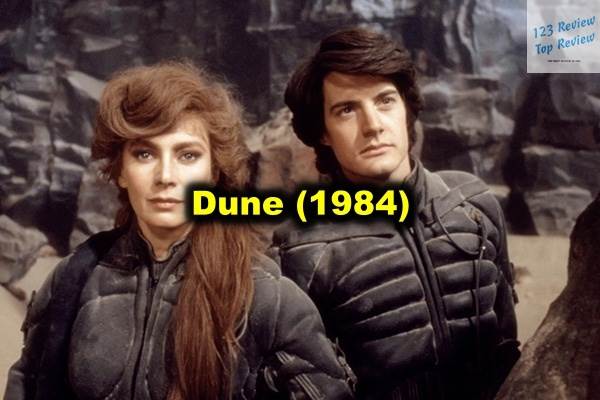Despite its initial mixed reception, the Dune (1984) movie has gained a significant following over the years, admired for its ambition, visual style, and the way it grapples with complex themes. Adapted from Frank Herbert’s seminal 1965 novel, “Dune” was a monumental undertaking that sought to translate a richly detailed and intricate narrative into a visual medium. The film is a layered exploration of power, destiny, and the human spirit, set against the backdrop of a distant, desolate planet where control over a vital resource, known as “spice,” dictates the fate of empires.

In this article, 123 Review delves deeply into the various aspects that make “Dune” (1984) a subject of ongoing discussion and analysis. We will explore its thematic richness, cinematic techniques, character portrayals, and the legacy it has left in the realms of science fiction and popular culture. Through a detailed examination, we aim to understand the significance of this film, its impact, and why it continues to captivate audiences and inspire debate.
Themes and Motifs
At its core, “Dune” (1984) is a film deeply rooted in themes and motifs that explore the human condition, the nature of power, and the tension between fate and free will. David Lynch’s interpretation of Frank Herbert’s novel brings these themes to life in a way that is both visually arresting and intellectually stimulating.
Spiritual Journey of Paul Atreides
The spiritual journey of Paul Atreides is the backbone of the “Dune” narrative. Paul’s evolution from the heir of House Atreides to the prophetic figure known as the Kwisatz Haderach is not merely a journey of political ascension but a profound spiritual awakening. This transformation is depicted through Paul’s visions, which are both haunting and prophetic, revealing the future and his role in it. These visions are a cinematic representation of Paul’s internal struggle, reflecting his grappling with the immense power and responsibility that comes with his destiny.
Paul’s journey can be seen as an allegory for the hero’s journey, a concept explored in depth by mythologist Joseph Campbell. However, unlike the traditional hero’s journey, Paul is acutely aware of the potential consequences of his actions, which adds layers of complexity to his character. His reluctance to embrace his destiny and the burden of his prescient abilities make his journey a deeply existential one, where the lines between choice and inevitability blur.
Overcoming Tyranny and Power
The struggle against tyranny and the misuse of power is a central theme in “Dune.” The film portrays the conflict between the noble House Atreides and the malevolent House Harkonnen, which is backed by the corrupt Emperor Shaddam IV. This battle for control over the desert planet Arrakis, the sole source of the precious spice melange, is not just a physical conflict but a symbol of resistance against oppressive forces.
The Harkonnens, led by the grotesque Baron Vladimir Harkonnen, represent the epitome of corrupt and tyrannical rule. Their exploitation of Arrakis and its people, the Fremen, highlights the destructive nature of unchecked power. In contrast, the Atreides family, under Duke Leto and later Paul, embodies the ideal of just and benevolent leadership, although they too are not immune to the corrupting influence of power.
The film’s exploration of power dynamics extends beyond the obvious good versus evil dichotomy. It delves into the manipulation of religion and prophecy as tools of control. The Bene Gesserit, a secretive sisterhood with their own political agenda, have long manipulated bloodlines to produce a superbeing—the Kwisatz Haderach—whom they intend to control. Paul’s emergence as this figure, yet beyond their control, sets the stage for a rebellion not just against external tyranny but against the forces that seek to dictate the course of human evolution.
Duality of Fate and Free Will
“Dune” is deeply concerned with the duality of fate and free will, a theme that is personified in the character of Paul Atreides. Paul’s prescient abilities allow him to see multiple possible futures, but this knowledge becomes a burden as it raises questions about his autonomy. Is Paul merely following a predestined path, or does he have the power to change his fate? This tension is central to the narrative and is explored through Paul’s decisions and the consequences that follow.
Throughout the film, Paul is confronted with visions of a jihad carried out in his name, a future he desperately wishes to avoid. These visions force him to confront the possibility that his rise to power could lead to widespread destruction, challenging the notion that he is merely a savior figure. The duality of fate and free will in “Dune” raises philosophical questions about the nature of destiny and the extent to which individuals can shape their own futures. This theme resonates with audiences, as it touches on universal concerns about control, agency, and the ethical implications of power.
Cinematic Techniques
David Lynch’s “Dune” is as much a visual and auditory experience as it is a narrative one. The film’s unique cinematic techniques play a crucial role in immersing the audience in the alien world of Arrakis and conveying the film’s complex themes.
Use of Color and Visual Aesthetics
Lynch’s use of color and visual aesthetics in “Dune” is instrumental in creating the film’s otherworldly atmosphere. The visual design of the film is heavily influenced by the stark contrasts between the various settings—the desolate, sandy expanses of Arrakis, the lush green of Caladan, and the dark, industrial interiors of the Harkonnen stronghold on Giedi Prime.
The color palette is meticulously chosen to evoke specific emotional responses and to symbolize broader themes. For example, the dominance of earth tones and shades of brown in the scenes on Arrakis emphasizes the harshness and barrenness of the desert planet, while the oppressive, black-and-red hues associated with House Harkonnen underscore their malevolence and the toxic nature of their rule. The frequent use of blue, particularly in the eyes of the spice-addicted Fremen, symbolizes the mystical and transformative power of the spice melange, linking it to the film’s exploration of spirituality and the unknown.
Lynch’s visual approach also extends to the film’s costumes and set designs, which are both elaborate and symbolic. The ornate, almost baroque costumes of the Emperor and his court contrast sharply with the utilitarian garb of the Fremen, reflecting the vast gulf between the ruling elite and the oppressed. The sets, particularly the grandiose palaces and the Harkonnen’s grotesque industrial environments, are designed to be both awe-inspiring and unsettling, reinforcing the film’s themes of power and corruption.
Special Effects and Practical Effects
For a film produced in the early 1980s, “Dune” (1984) was ambitious in its use of special effects, blending practical effects with emerging technologies to create a visually arresting experience. The depiction of the giant sandworms, creatures integral to the mythology of “Dune,” is a standout achievement. Created using practical effects, including scale models and animatronics, these sandworms convey a sense of awe and terror that is central to the film’s atmosphere. The practical effects work, though constrained by the technology of the time, adds a tangible quality to the creatures, making them feel real and menacing.
Lynch also employed a range of visual effects to create the film’s more fantastical elements, such as the shields worn by characters during combat. These shields, represented by a blocky, shimmering effect, were groundbreaking at the time, though they may appear dated to modern audiences. Despite these limitations, the effects contribute to the film’s distinct visual style, setting it apart from other science fiction films of the era.
The film’s depiction of space travel and the use of folding space—an advanced form of faster-than-light travel enabled by the spice—are also notable. These sequences are rendered with a combination of practical models and special effects, creating a visually surreal experience that aligns with the film’s overall tone. The wormhole-like visuals during the space-folding scenes reflect Lynch’s interest in the abstract and the mysterious, reinforcing the film’s themes of the unknown and the mystical.
Surrealistic Elements in Filmmaking
David Lynch is known for his use of surrealism, and “Dune” (1984) is no exception. The film is infused with surrealistic elements that heighten the sense of otherworldliness and emphasize the psychological and mystical aspects of the story. Lynch’s surrealism is most evident in the dream sequences and Paul’s visions, which are depicted with a blend of abstract imagery, nonlinear narrative techniques, and unsettling soundscapes.
These sequences are deliberately disorienting, intended to mirror Paul’s own confusion and fear as he navigates his emerging powers. The use of slow-motion, distorted sound, and bizarre visual juxtapositions in these scenes contributes to the film’s eerie, dreamlike quality. For instance, the recurring image of the moon with the Fremen’s blue eyes superimposed over it is a striking visual metaphor for Paul’s destiny and the pervasive influence of the spice.
Lynch’s use of surrealism also extends to the portrayal of the film’s villains, particularly the Harkonnens. The Baron’s grotesque physicality and his sadistic tendencies are exaggerated to the point of absurdity, creating a nightmarish quality that is both unsettling and memorable. This exaggerated portrayal aligns with Lynch’s broader approach to the film, where reality is often distorted, and the boundaries between the conscious and subconscious are blurred.
Character Analysis
The characters in “Dune” (1984) are not only central to the plot but also serve as embodiments of the film’s major themes. Through their interactions and development, we gain deeper insight into the world of “Dune” and the forces that drive the narrative.
Paul Atreides as the Protagonist
Paul Atreides, portrayed by Kyle MacLachlan in his film debut, is the central figure around whom the story revolves. Paul’s character arc is one of the most compelling aspects of the film, as it charts his transformation from a young nobleman into the Kwisatz Haderach, a messianic figure prophesied to lead a revolution. Paul is a character caught between the expectations placed upon him by his lineage and the terrifying knowledge of his potential future.
Paul’s journey is marked by a series of trials that test his physical, mental, and spiritual limits. Early in the film, he undergoes the Gom Jabbar test administered by the Bene Gesserit, a painful ordeal that measures his ability to control his instincts and emotions. This test is symbolic of the inner strength Paul must develop to face the challenges ahead. As he becomes more attuned to his prescient abilities, Paul begins to see the paths that his life might take, leading to a growing awareness of the heavy burden of leadership.
Throughout the film, Paul grapples with his identity and the expectations of those around him. His father, Duke Leto, represents the noble ideals of leadership, while his mother, Lady Jessica, embodies the spiritual and mystical aspects of his heritage as a member of the Bene Gesserit. Paul’s struggle to reconcile these influences and forge his own path is central to the film’s exploration of fate and free will. As the story progresses, Paul’s initial reluctance gives way to a determined resolve, but not without a sense of foreboding about the potential consequences of his rise to power.
Villains: Baron Harkonnen and His Influence
Baron Vladimir Harkonnen, portrayed by Kenneth McMillan, is one of the most memorable villains in science fiction cinema. His character is a grotesque caricature of decadence and corruption, embodying the worst excesses of power. The Baron’s physical appearance—bloated, diseased, and reliant on anti-gravity suspensors to move—reflects the moral decay that underpins his rule. Lynch’s portrayal of the Baron is deliberately exaggerated, emphasizing his sadism and his insatiable hunger for power.
The Baron’s influence extends far beyond his physical presence. As the head of House Harkonnen, he orchestrates the downfall of House Atreides, setting the events of the film in motion. His manipulation of political alliances, particularly his collusion with the Emperor, reveals the depths of his cunning and the lengths he is willing to go to maintain control over Arrakis. The Baron’s relationship with his nephews, particularly the psychopathic Feyd-Rautha (played by Sting), further highlights his twisted approach to power, as he molds them into instruments of his will.
Baron Harkonnen’s characterization is a study in the corrosive effects of absolute power. His rule over Giedi Prime is marked by environmental destruction and the exploitation of its people, serving as a dark mirror to the potential future of Arrakis under similar tyrannical rule. The Baron’s eventual downfall is portrayed with a mix of horror and dark humor, fitting for a character who embodies the extremes of villainy.
Supporting Characters: Impact on the Narrative
The supporting characters in “Dune” (1984) play crucial roles in shaping the narrative and deepening the film’s thematic complexity. Characters such as Duke Leto Atreides, Lady Jessica, and Stilgar, the leader of the Fremen, provide different perspectives on the central conflicts and enrich the story.
Duke Leto Atreides, portrayed by Jürgen Prochnow, is the noble and honorable ruler of House Atreides. His leadership style contrasts sharply with that of the Harkonnens, as he seeks to govern with fairness and respect for the people of Arrakis. Leto’s decision to accept the Emperor’s fateful offer to take control of Arrakis is driven by his desire to bring stability and prosperity to the planet, though it ultimately leads to his downfall. His death is a pivotal moment in the film, setting Paul on his path toward leadership and vengeance.
Lady Jessica, played by Francesca Annis, is a complex character who embodies the intersection of political intrigue and spiritual depth. As a member of the Bene Gesserit, Jessica is both a mother and a manipulator, having defied the sisterhood’s orders by bearing a son instead of a daughter. Her loyalty to Paul and her influence on his development are central to the story, as she trains him in the ways of the Bene Gesserit while grappling with her own sense of duty and love.
Stilgar, portrayed by Everett McGill, is the leader of the Fremen and a key ally to Paul in his quest to overthrow the Harkonnens. Stilgar represents the resilient and resourceful spirit of the Fremen, a people who have adapted to the harsh environment of Arrakis and maintained their independence in the face of imperial exploitation. His character serves as a bridge between Paul’s aristocratic background and the harsh realities of life on Arrakis, highlighting the importance of unity and leadership in the face of tyranny.
Other supporting characters, such as Gurney Halleck (Patrick Stewart), Thufir Hawat (Freddie Jones), and Duncan Idaho (Richard Jordan), contribute to the film’s exploration of loyalty, honor, and the complexities of power. Each character brings their own strengths and weaknesses to the story, enriching the narrative and providing different lenses through which to view the unfolding events.
Criticism and Reception
Upon its release, “Dune” (1984) was met with a mixed reception, both from critics and audiences. While some praised its ambition and visual style, others found it confusing and inaccessible. Over the years, however, the film has been re-evaluated, gaining a cult following and a more nuanced appreciation.
Critical Reception at Release
When “Dune” was released in December 1984, it faced significant challenges at the box office. The film’s dense plot, which attempted to condense Herbert’s sprawling novel into a two-hour runtime, left many viewers bewildered. Critics were divided, with some praising Lynch’s bold visual style and others criticizing the film’s incoherent narrative and stilted dialogue. The New York Times described the film as “a real mess,” while Roger Ebert famously called it “a failure” that was “incomprehensible, ugly, unstructured, and pointless.”
Despite these harsh reviews, some critics acknowledged the film’s artistic merits. The film’s production design, special effects, and score were generally well-received, with particular praise for the atmospheric depiction of Arrakis and the imaginative portrayal of its alien landscapes. However, these strengths were often overshadowed by the film’s perceived weaknesses, particularly its pacing and narrative clarity.
Audience Perception Over the Years
While “Dune” (1984) struggled to find its audience upon initial release, it has since become a cult classic, with a dedicated fanbase that appreciates its unique qualities. Over the years, the film has been re-evaluated by both fans and critics, who have come to see it as an ambitious, if flawed, adaptation of Herbert’s novel. The film’s surrealistic elements, which were initially off-putting to many viewers, are now recognized as part of Lynch’s distinctive directorial style.
Fans of the film often cite its atmospheric world-building, memorable characters, and haunting soundtrack as reasons for its enduring appeal. The film’s flaws, such as its rushed ending and occasional narrative incoherence, are often viewed more leniently in retrospect, seen as the result of trying to adapt a complex and sprawling novel within the constraints of a feature-length film.
The cult status of “Dune” (1984) has also been bolstered by its influence on later works of science fiction. Filmmakers, writers, and artists have drawn inspiration from its visual style and thematic depth, contributing to the film’s legacy as an important, if controversial, piece of cinema.
Comparison with Frank Herbert’s Novel
One of the most significant points of contention regarding “Dune” (1984) is how it compares to Frank Herbert’s original novel. Herbert’s “Dune” is widely regarded as one of the greatest science fiction novels of all time, known for its intricate world-building, complex characters, and exploration of themes such as ecology, religion, and politics. Adapting such a rich and detailed novel into a two-hour film was always going to be a challenge, and Lynch’s adaptation has been both praised and criticized for how it handled this task.
Lynch’s “Dune” takes certain liberties with the source material, condensing and altering parts of the story to fit the constraints of the film format. Some of the novel’s more subtle elements, such as the intricate political machinations and the ecological themes, are downplayed or omitted entirely. This has led to criticism from fans of the book, who feel that the film fails to capture the full depth and complexity of Herbert’s work.
However, Lynch’s interpretation of “Dune” also brings new elements to the story that are not present in the novel. The film’s surrealistic visuals and emphasis on the psychological aspects of Paul’s journey offer a different perspective on the narrative, one that is more concerned with the internal, spiritual dimensions of the story than with the external, political ones. This approach has its own merits, even if it diverges from the source material, and has been appreciated by those who value Lynch’s distinctive cinematic style.
Cultural Impact
Despite its initial reception, “Dune” (1984) has had a lasting impact on the science fiction genre and popular culture at large. Its influence can be seen in a variety of media, from films and television to literature and video games.
Influence on Science Fiction Genre
“Dune” (1984) has had a significant influence on the science fiction genre, both in terms of its visual style and its thematic depth. The film’s portrayal of a distant future, where advanced technology coexists with feudal political structures, has inspired countless other works of science fiction. The film’s distinctive aesthetic, characterized by its grand, baroque designs and its use of surrealistic imagery, has also left a lasting mark on the genre.
The film’s influence is particularly evident in the way it portrays the relationship between humans and their environment. The depiction of Arrakis as a harsh, unforgiving world where survival depends on understanding and respecting the ecosystem has resonated with audiences and creators alike, inspiring other works that explore the theme of environmental stewardship. This focus on ecology and the consequences of exploitation is a key element of Herbert’s novel, and while Lynch’s film may not explore it as deeply, its visual representation of the desert planet has become iconic.
Legacy of Dune (1984) in Popular Culture
Over the years, “Dune” (1984) has become a touchstone in popular culture, referenced and parodied in various forms of media. The film’s striking imagery, from the sandworms of Arrakis to the eerie, blue-eyed Fremen, has been etched into the collective memory of science fiction fans. Elements of the film, such as the use of the “Voice” by the Bene Gesserit and the concept of the Kwisatz Haderach, have also found their way into broader pop culture, influencing everything from video games to music.
The film’s cult status has been cemented by its continued relevance in discussions about science fiction cinema. “Dune” (1984) is often cited alongside other seminal works of the genre, such as “Blade Runner” (1982) and “2001: A Space Odyssey” (1968), as a film that pushed the boundaries of what science fiction could achieve on screen. Its legacy is also evident in the continued interest in adapting Herbert’s novel, with each new adaptation inevitably being compared to Lynch’s vision.
Adaptations and Reboots: How They Compare
The legacy of “Dune” (1984) is further complicated by the various attempts to adapt Herbert’s novel over the years. The most notable of these is the 2021 adaptation directed by Denis Villeneuve, which was widely praised for its fidelity to the source material and its epic scope. Villeneuve’s “Dune” contrasts sharply with Lynch’s version, offering a more straightforward, though still visually stunning, interpretation of the novel.
While Villeneuve’s “Dune” has been lauded for its ability to convey the complexity of Herbert’s world, Lynch’s version remains a unique and singular vision. The 1984 film’s emphasis on the psychological and surrealistic aspects of the story, as well as its bold artistic choices, set it apart from other adaptations. For many fans, Lynch’s “Dune” remains an intriguing, if flawed, experiment—a film that dared to take risks, even if it didn’t always succeed.
The various adaptations of “Dune” over the years, including a 2000 miniseries, highlight the challenges of bringing Herbert’s novel to the screen. Each version has its strengths and weaknesses, and the ongoing interest in adapting “Dune” speaks to the enduring appeal of Herbert’s creation and the fascination with the world he built.
Director’s Vision
David Lynch’s vision for “Dune” (1984) was both ambitious and personal. Known for his surreal and often disturbing films, Lynch brought his unique sensibilities to the adaptation, resulting in a film that is as much a reflection of his artistic vision as it is an adaptation of Herbert’s novel.
David Lynch’s Interpretation of the Source Material
Lynch’s interpretation of “Dune” diverges in many ways from Herbert’s original novel, reflecting the director’s own interests and preoccupations. Where the novel is deeply concerned with political intrigue, environmentalism, and the complex interplay of various factions, Lynch’s film is more focused on the psychological and mystical aspects of the story. This shift in focus is evident in the film’s emphasis on Paul’s internal journey and the surreal, dreamlike quality of many of its scenes.
Lynch’s “Dune” also incorporates elements of horror and the grotesque, particularly in the portrayal of the Harkonnens. The film’s depiction of Baron Harkonnen and his followers is marked by a sense of decay and corruption that goes beyond mere villainy, turning them into almost monstrous figures. This approach is in keeping with Lynch’s broader body of work, where the grotesque often serves as a manifestation of underlying psychological or societal issues.
Despite these divergences, Lynch’s film remains true to the spirit of Herbert’s novel in many ways. The themes of destiny, power, and the struggle for control over Arrakis are all present, even if they are explored through a different lens. Lynch’s interpretation is one that prioritizes mood, atmosphere, and visual symbolism over straightforward narrative, resulting in a film that is more of an experience than a traditional adaptation.
Artistic Choices and Their Reception
The artistic choices made by Lynch in “Dune” (1984) were bold and, at times, polarizing. The film’s visual style, with its elaborate set designs, distinctive costumes, and use of color, was both praised and criticized. Some saw it as a masterful creation of an alien world, while others found it overwhelming or too abstract. The use of internal monologues, a technique borrowed from the novel, was another point of contention, with some viewers finding it an effective way to convey the characters’ thoughts, while others felt it was intrusive.
Lynch’s decision to include surrealistic elements, such as the dream sequences and the depiction of Paul’s visions, was also divisive. These scenes are among the most memorable in the film, but they also contribute to the film’s reputation for being difficult to follow. The blend of traditional science fiction tropes with Lynch’s idiosyncratic style created a film that was unlike anything else in the genre, which was both its greatest strength and its greatest weakness.
The reception of Lynch’s artistic choices has evolved over time. What was once seen as a flawed and confusing film has, for many, become a fascinating and daring piece of cinema. Lynch himself has expressed mixed feelings about the film, acknowledging the difficulties he faced during its production and the compromises that were made. Despite this, “Dune” (1984) remains a testament to Lynch’s unique vision and his willingness to take risks in his filmmaking.
Critique of 1980s American Society
While “Dune” (1984) is primarily a work of science fiction, it also reflects certain aspects of 1980s American society. The film’s portrayal of power struggles, environmental degradation, and the manipulation of religion can be seen as a commentary on the political and social issues of the time. The 1980s were marked by concerns about the environment, the rise of corporate power, and the influence of media and religion in shaping public opinion—all themes that resonate in “Dune.”
The film’s depiction of the exploitation of Arrakis and its resources can be read as a critique of the exploitation of natural resources in the real world, particularly in the context of the oil industry and its impact on geopolitics. The manipulation of religious prophecy in the film, where the Bene Gesserit’s breeding program and the myth of the Kwisatz Haderach are used to control the masses, echoes concerns about the use of ideology and propaganda in the 1980s to maintain power and influence.
Lynch’s “Dune” can also be seen as reflecting the anxieties of the time, particularly in its depiction of the Harkonnens and their corrupt, authoritarian rule. The Harkonnens’ use of fear, violence, and technological control mirrors the fears of totalitarianism and the loss of individual freedoms that were prevalent during the Cold War era. In this way, “Dune” (1984) is not just a film about a distant future, but also a reflection of the concerns and issues of its own time.
Major Scenes and Plot Points
“Dune” (1984) is filled with major scenes and plot points that define the film and contribute to its overall narrative. These moments are often rich in symbolism and thematic depth, making them key to understanding the film’s broader messages.
Significant Moments that Define the Film
One of the most significant moments in “Dune” (1984) is the Gom Jabbar test, where Paul must endure intense pain without succumbing to his animal instincts. This scene is crucial in establishing Paul’s character and his potential as the Kwisatz Haderach. The test also introduces the audience to the Bene Gesserit’s philosophy of self-control and the importance of overcoming primal fears, setting the stage for Paul’s later development.
Another pivotal scene is the betrayal and fall of House Atreides, orchestrated by the Harkonnens and the Emperor. This moment is the turning point in the film, where Paul’s life is upended, and he is forced to flee into the desert. The destruction of his family and the loss of their power are depicted with a sense of inevitability, emphasizing the themes of fate and the cyclical nature of history.
Paul’s first encounter with the Fremen and his acceptance as their leader is another defining moment. This scene marks the beginning of Paul’s transformation into the messianic figure of Muad’Dib, as he embraces his destiny and begins to unite the Fremen against their oppressors. The symbolism of Paul’s new name and his role as the leader of a desert people who are closely tied to the environment of Arrakis is central to the film’s exploration of power and leadership.
Climax and Resolution Analysis
The climax of “Dune” (1984) occurs during the final battle for control of Arrakis, where Paul leads the Fremen in a rebellion against the Harkonnens and the Emperor’s forces. This battle is a culmination of the film’s various themes and plot threads, as Paul uses both his strategic genius and his prescient abilities to achieve victory. The use of the sandworms as weapons by the Fremen is a dramatic and visually striking element, symbolizing the alliance between Paul and the natural world of Arrakis.
The resolution of the film, where Paul confronts the Emperor and the defeated Baron Harkonnen, brings the narrative full circle. Paul’s assertion of his right to rule as the Kwisatz Haderach is both a fulfillment of the prophecy and a moment of personal triumph. However, the film ends on a somewhat ambiguous note, with Paul’s victory raising questions about the future and the potential consequences of his newfound power. This ambiguity is reflective of the film’s broader themes, particularly the tension between destiny and free will.
Differences from the Book and Their Impact
The differences between “Dune” (1984) and Herbert’s novel have been a point of contention for fans and critics alike. Some of the most notable differences include the film’s condensation of the plot, the omission of certain subplots, and the altered ending. For example, in the film, Paul’s defeat of the Emperor is more straightforward and lacks the political intrigue and complexity of the novel. This simplification of the plot was likely a result of the need to fit the story into a two-hour runtime, but it has led to criticism that the film loses some of the depth and nuance of the source material.
Another significant difference is the portrayal of Paul’s abilities and his transformation into the Kwisatz Haderach. In the novel, this transformation is a gradual and complex process, whereas in the film, it is more sudden and is presented as a foregone conclusion. This change impacts the narrative by making Paul’s journey seem more linear and less fraught with uncertainty, which some argue diminishes the tension and drama of his character arc.
Despite these differences, Lynch’s “Dune” captures the essence of Herbert’s story in many ways. The film’s focus on the themes of destiny, power, and the relationship between humans and their environment are all central to the novel, even if they are explored in a different manner. The film’s visual and atmospheric interpretation of Arrakis and its inhabitants also remains a memorable and influential depiction, contributing to the lasting legacy of both the film and the original novel.
Conclusion
David Lynch’s “Dune” (1984) is a film that defies easy categorization. It is at once a flawed adaptation, a bold artistic experiment, and a cult classic that has influenced generations of science fiction creators. While it may not have been a commercial or critical success upon its release, its impact on the genre and its enduring appeal cannot be denied.
The film’s strengths lie in its ambitious visual style, its exploration of complex themes, and its memorable characters. Lynch’s interpretation of “Dune” is unique, offering a surreal and psychological take on Herbert’s epic story that sets it apart from other adaptations. Despite its shortcomings, “Dune” (1984) remains a fascinating and important work in the canon of science fiction cinema.
As the legacy of “Dune” continues to evolve with new adaptations and interpretations, Lynch’s film will likely remain a point of reference and discussion for fans and scholars alike. Its place in the history of science fiction is secure, not as a perfect film, but as a daring and imaginative attempt to bring one of the most challenging and beloved novels of the genre to life on the big screen.





